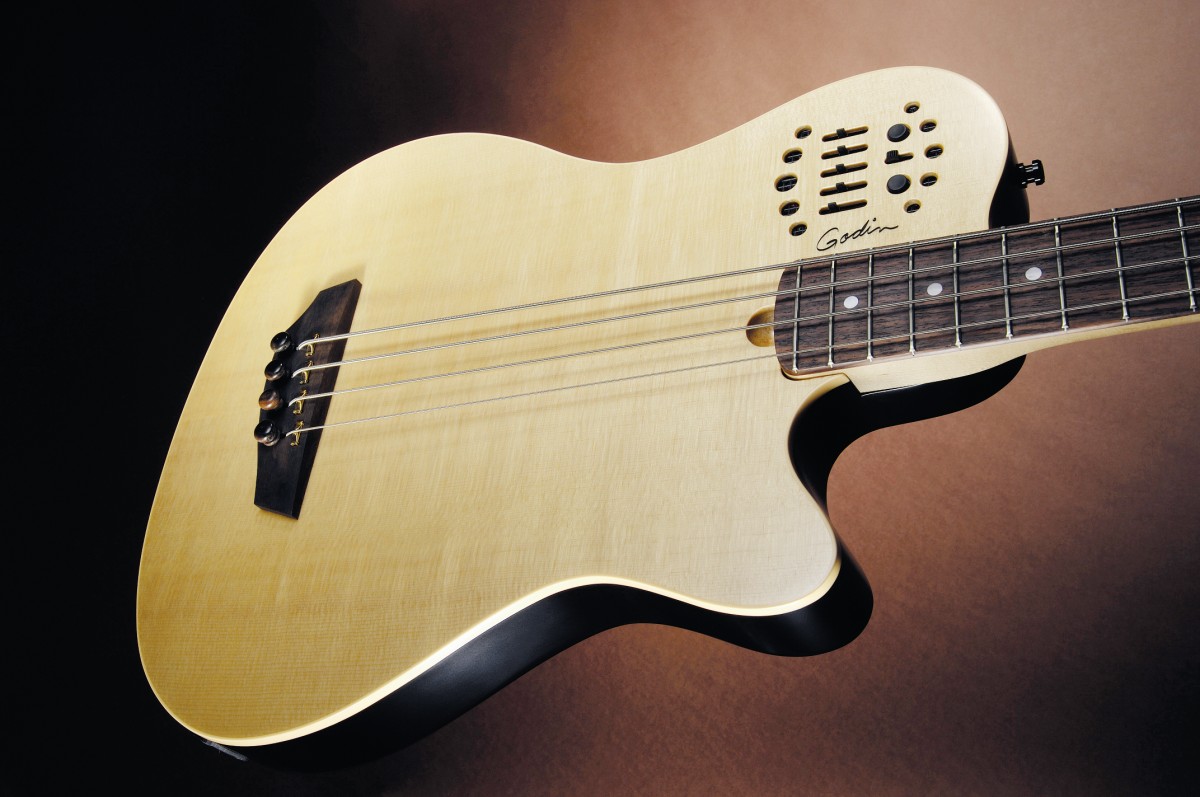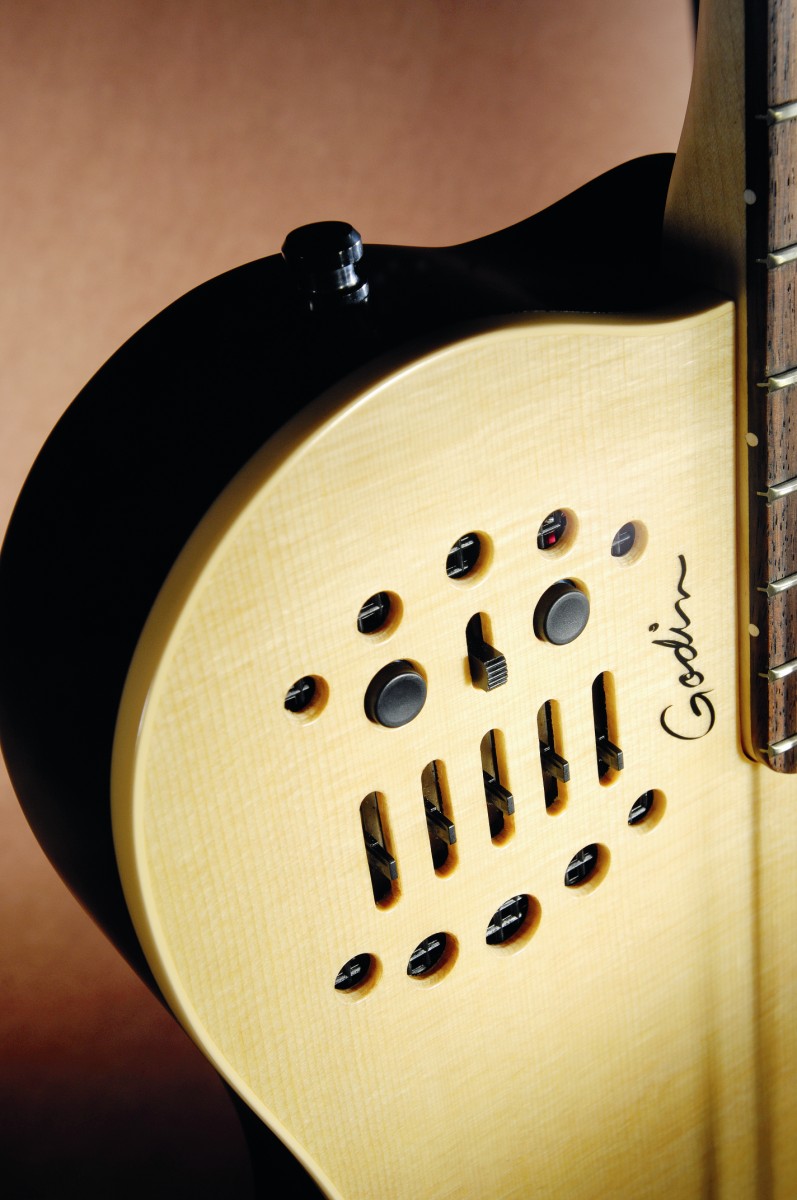MusicRadar Verdict
If you want the sounds of an acoustic bass yet prefer the feel of a solidbody electric then this instrument is an ideal choice.
Pros
- +
Acoustic bass appearance with solid body feel. Plethora of sounds.
Cons
- -
None.
MusicRadar's got your back

Godin A4 SA sem-acoustic bass

Godin A4 SA sem-acoustic bass

Godin A4 SA sem-acoustic bass
Perceived as the top model in the Godin bass range, the A4 is essentially a slimline electro-acoustic bass in looks and sounds, but with a definite electric bass guitar feel about it.
This version has the SA suffix - SA stands for Synth Access, not semi-acoustic - and the instrument is equipped with a 13-pin output socket that allows connection to outboard devices (like Roland's GR-33).
Godin is one of the few companies that cater for this market - pioneered with the Multiac six-string - and while it was once seen as the 'new frontier' for the electric guitar and bass, the reality is that it's a niche, although one that for the creative musician is remarkably powerful.
But what of the bass itself, both as a standalone instrument and as the vehicle for producing great and varied sounds when using the synth link?
Overview
Without a doubt Godin's A4 SA (and the A5, the five-string version) bass is rather special. The 'acoustic' appearance neatly hides the fact that this has always been a very sophisticated design.
The controls are designed to look like a slotted soundhole (they do act as a sound port as well) and now along with the EQ and other controls we get the additional program stepping that the synth-ready system requires.
You may have noticed that visually, little has changed from the earlier A4 model.
The SA models now use a spruce rather than cedar top and when you look closely at the bridge you'll notice it's a little more angled and uses individual custom Godin/RMC saddle transducers.
As with the rest of the A Series instruments, the body features sound chambers that add a sort of woodiness to the acoustic sound quality of the bass, plus they play a useful part in reducing the weight.
The body back is made from silver leaf maple and the natural top is solid spruce, giving the instrument a highly contemporary look.
Contrasting this is the black gloss of the headstock face, and this serves to mimic the darkness of the bridge, like buffers at either end of a train line, with quite beautiful results.
A pair of string trees are set into the headstock to make sure that all four strings have sufficient break angle behind the nut.
Another piece of good news is that the price includes a good quality canvas gigbag with extra neck protection and multiple internal pockets - ideal for any bass player on the move. Both the A4 and A5 are also available fretless.
Of course, if you wish to make use of the 13-pin facility you will need to plug into something like the Roland GR-20.
While the GR-20 is designed to sit on the floor, a GI-20 will need additional footswitches for live use but remains very powerful; "The best Guitar-MIDI Interface on the planet," boasts Roland, and we're not arguing.
Both offer fast note tracking with no discernable latency from plucking to electrified sound. As for what you ultimately want to feed it through, however, well that's entirely up to you.
In use
It was the manufacturer's intention of producing a cross between a solid-bodied and an acoustic bass, and the A4 SA not only looks the part, but feels it too.
It's a whole lot more comfortable to play than a fully sized acoustic bass even if it does mean a little gain in overall weight.
The general balance is a little headstock-heavy but nothing like as bad as you experience when playing a traditionally styled, fully acoustic bass guitar.
The neck, in particular, feels more like a regular solid bass - another plus point in our book. Both the standard jack and the 13-pin socket are housed on a plate on the lower body edge.
In fact, as far as the sound qualities of this bass are concerned, everything is very positive indeed.
The three-band EQ sliders work from a centre detent for easy reference and the regular volume and the synth volume are located above and below respectively.
The overall tonal range seems quite restricted compared with some EQs, because the bass, mid and treble controls are concentrated around the most used frequencies.
But by ignoring those unnecessary high and low extremities, this EQ allows for more precise adjustment within the range provided and consequently produces a tightly focused sound with improved dynamics.
There is such solidarity of sound here, far more in keeping with magnetic pickups rather than piezo transducers, yet the bass remains capable of providing these glorious acoustic-style sounds with the minimum of effort.
The bottom end in particular has a phenomenal richness that provides a wonderful foundation on which to create your own sound.
The top end neatly avoids the harshness that many transducer-led systems suffer from, and the mid frequency adjustment is well chosen to solidify and enhance the presumed acoustic qualities of the A4SA.
Better still, the thin-line chambered body design helps to reduce the chance of feedback occurring during a live performance.
Obviously linking this directly into a synth opens up a new world of sound possibilities but the important aspect here is that none of the excellent sound qualities associated with the A4 has been compromised for this added ability - a seriously big plus all round.
““We were arguing a lot and we were miserable”: How Green Day exceeded expectations with their most ambitious song
"There’s plenty for us guitarists to learn – and ‘less is more’ is the overriding lesson": how to play like George Harrison on The Beatles' Abbey Road
“They didn’t like Prince’s bikini underwear”: Prince’s support sets for the The Rolling Stones in 1981 are remembered as disastrous, but guitarist Dez Dickerson says that the the crowd reaction wasn’t as bad as people think









